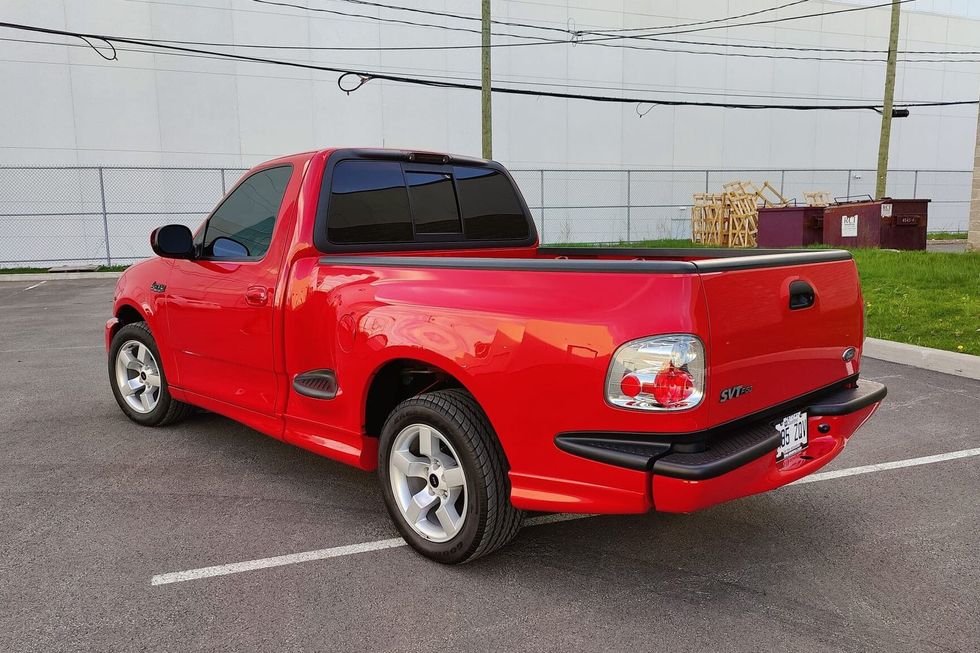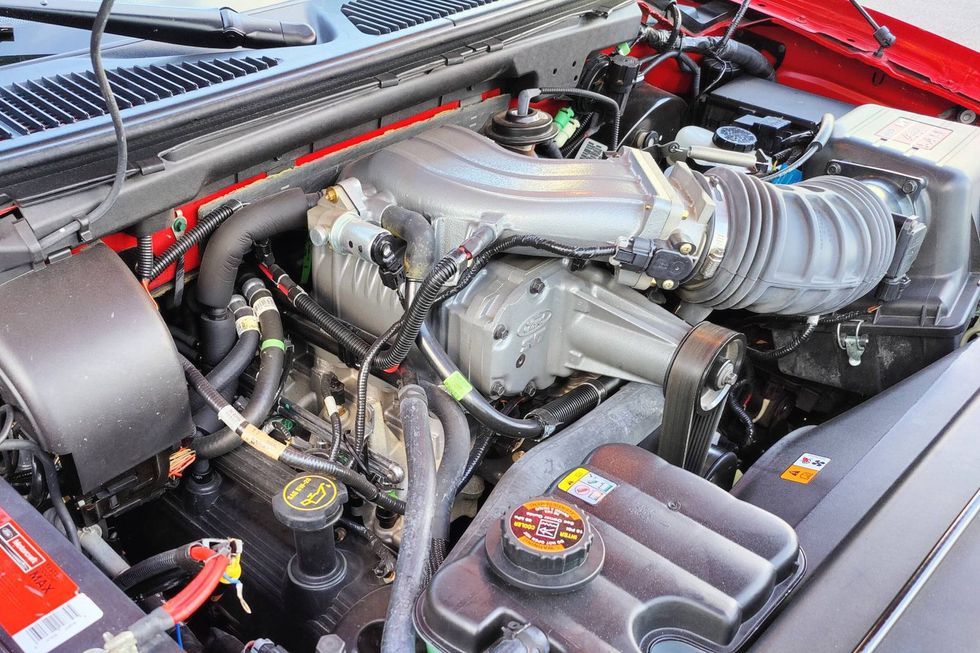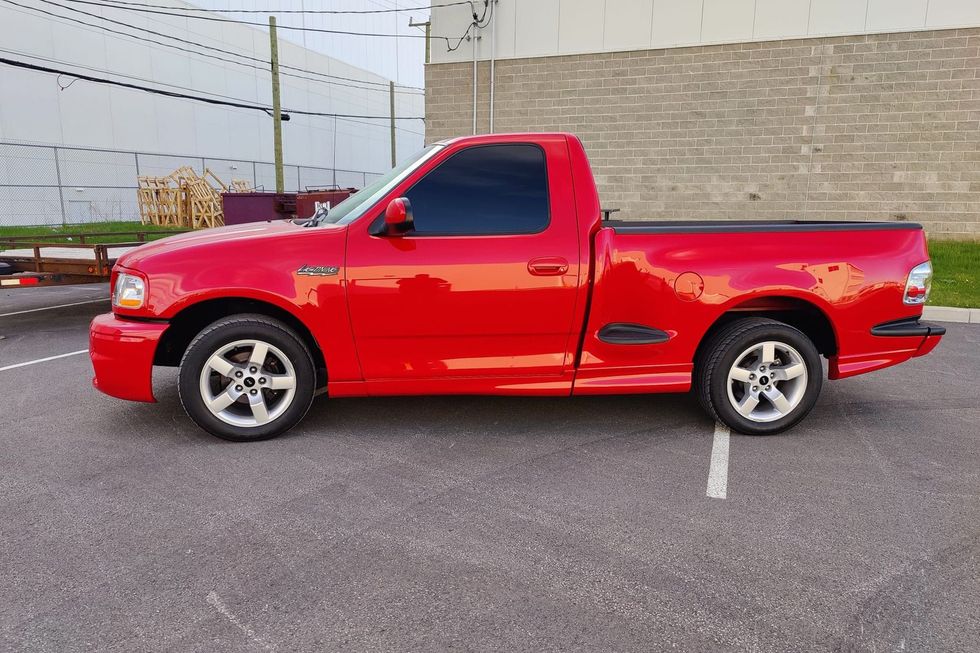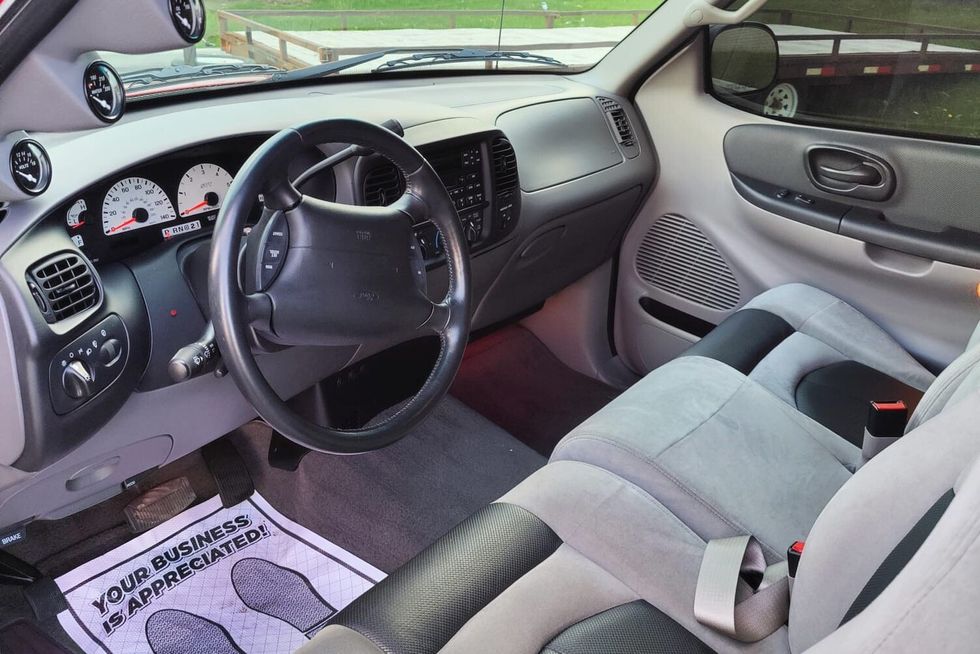Fashionably Finned - 1957 Dodge Sweptside D100
Looking sharp from any angle, Dodge's 1957 Sweptside D100 just may be the prettiest pickup truck ever built
09/23/2018


Truck buyers are often slaves to function, but they clearly don't ignore fashion. Dodge proved this in 1994 when it pulled the wraps off a new line of "big rig" styled Rams. Not only was the company rewarded with a hefty sales increase over the year prior, but this breakthrough design influenced pickup styling throughout the early 21st century.
And Dodge definitely needed the boost. Through the 1980s, the Ram brand often struggled to hang onto its share of the full-size light truck market. The introduction of the Cummins turbo diesel for 1989 was a major coup, but the exciting new engine was powering trucks that had been rolling along virtually unchanged since 1972.
Prior to the 1980s, though, there were milestones that showed that Dodge could make bold fashion statements in trucking when necessary: The Lil' Red Express in 1978, the introduction of the first club cab in 1973, the crew cab design in 1963 and the now-iconic Sweptside body of 1957.
Of all of Dodge's stylish trucking triumphs, the Sweptside stands out because it was a parts-bin project put together outside of Virgil Exner's design studios, conceived of and assembled by Dodge's Special Equipment Group. The Special Equipment Group was sort of an in-house customizing shop established to modify production trucks in order to meet the needs of individual or fleet customers. SEG had the authority to make any changes it deemed necessary, independent of factory engineers, as long as those changes didn't compromise operator or passenger safety.
By 1957, Dodge's trucks were looking pretty dowdy compared to GM's industry-leading Task Force offerings, with their available fiberglass-sided fleetside cargo beds. Ford, too, was offering a radically restyled F-150, as well as the half-car half-truck Ranchero. Meanwhile, Dodge truck sales continued the downward slide that had plagued the company since 1947.
Joe Berr, the manager of Dodge's Special Equipment Group, is said to have come up with the plan for the 1957 Dodge Sweptside, which was introduced partway through the model year in an attempt to spice up Dodge's truck line.
Berr first acquired a set of new quarter panels for a 1957 Dodge two-door station wagon. Then, the rear fenders were yanked off the cargo box of a new 1957 Dodge long-wheelbase two-wheel-drive half-ton pickup. Quarter panels from the Dodge car were adapted to fit the sides of the truck box. The bumper from the station wagon was also used, and it's said that the truck tailgate had to be modified to fit with the car fenders.
To further integrate the finned quarter panels with the truck cab, special chrome trim was added, as was as a two-tone paint scheme.
Finished, the Sweptside concept was a hit with Dodge dealers and the trucks were built--though never on the production line. Only a couple thousand of these special factory customs were assembled in 1957 through the 1958 model year, and they were discontinued in 1959.
The truck that the Sweptside was based on was introduced in 1954 and continued until 1960 with mostly evolutionary changes. The big news in 1954 was the availability of the poly-head 241-cu.in. V-8 engine, beginning in June of that year. The 1955 model year brought changes to Dodge truck cabs including wraparound front and rear glass, as well as an optional three-speed manual transmission with overdrive. Perhaps even more significantly, an automatic transmission with a torque converter was available for the first time; the old Fluid Drive setup was dropped.
For 1957, Dodge brought the "Forward Look" from its passenger cars to the truck line. The front fenders were drawn forward to mimic the cars' hooded headlamps and for the first time, the hood was one piece, hinged from the rear, rather than a two-piece design hinged in the center.
Further upping the ante, Dodge made the 315-cu.in. 204hp V-8 engine the standard V-8 in 1957, thus making it the largest engine available in any light truck. Even the 230-cu.in. L-head straight-six engine received a 5hp shot in the arm, thanks to a boost in compression, giving it a total of 120hp.
A three-speed automatic transmission was also available in 1957 Dodge trucks, complete with pushbutton shifter. Plus, 12-volt electrical systems became standard issue.
Another iconic Dodge made its debut in 1957--the conventional cab four-wheel-drive Power Wagon. The W100 half-ton and W200 three-quarter-ton Power Wagons were more civilized than the famous military truck of the same name. In addition to sharing sheetmetal with the two-wheel-drive Dodge trucks, the 4x4 conventional cabs could be had with the 315-cu.in. V-8, while military-derived models soldiered on with L-head straight-six power. The military Power Wagons, which were rated as one-tons, were known as WM300 to distinguish them from the W300 conventional cab one-ton 4x4.
Dodge truck buyers would have to wait until 1961 for an all-new pickup truck from the Ram brand, which brought with it the introduction of the thrifty slant-six engine in trucks. In general, 1950s Dodge trucks remain a collectible bargain today, as they don't enjoy the widespread popularity of Fords and Chevrolets of the same vintage. Dodge Sweptside trucks, as well as early 4x4s, are relatively rare, though. They are highly collectible and highly sought after, so buyers can expect to pay premium prices.
Forget Ford’s groundbreaking electric truck for a moment to consider this 2001 Ford SVT F-150 Lightning now offered on Hemmings Auctions. Instead of the dual permanent-magnet motors found in the current electric Lightning, the 1999-2004 SVT Lightning featured a supercharged version of Ford’s 5.4-liter “modular” OHC V8. Rated at 380 horsepower in the 2001-’04 models, it was good enough to make a stock lightning a formidable opponent on the street as well as at the strip.
A follow-up to the original 1993-’95 F-150 Lightning, which was a high-performance version of a standard F-150, the second-generation SVT super truck presented as a more thoroughly developed model with a lot more exclusive components that further differentiated it from the rest of the F-Series lineup. Beyond the engine, the entire suspension and braking system, not to mention aerodynamic body add-ons, were part of the Lightning package from 1999 through 2004. Exclusive interior components were also part of the package.
At the heart of this SVT Lightning is its iron-block 5.4-liter SOHC, 16-valve V8 with a supercharger and an intercooler. The blower helped it deliver 380 horsepower and 450 lb-ft of torque in 2001, up some 20 horsepower and 10 lb-ft from the ’99 and 2000 models. The Eaton supercharged engine delivered peak boost of 8.0 psi and the engine featured an 8.4:1 static compression ratio, down from the standard 5.4 V8’s 9.0:1, which was rated at 260 horsepower and 350 lb-ft.
Power reached the rear 18-inch cast aluminum-alloy wheels via a four-speed automatic, an aluminum driveshaft and a beefy 9.75-inch, limited-slip rear axle with an acceleration-friendly 3.73:1 final-drive ratio, another upgrade for 2001. Car and Driver magazine reported a 0-60 mph time of 5.2 seconds and a quarter-mile in an E.T. of 13.8 seconds at 104 mph—impressive numbers for a 4,600-pound truck. Top speed was a drag-limited 142 mph.

Trucks generally require a suspension that can handle a full load in its bed while also providing competent driving while empty. But if you fancy one designed to a sports-car standard, then something has to give. In the case of the second-gen Lightning, Ford dropped its payload capacity to a mere 800 pounds. A standard 2001 F-150 Styleside carried a 3,180-pound payload rating, while an F-150 Flareside was rated at 2,005 pounds, some two-and-a-half times the Lightning, which featured the short-bed Flareside body. Towing capacity, likewise, was reduced from 8,800 pounds to 5,000 in the Lightning. But the Lightning’s strengths were never its payload or towing capacities, but it’s ability to perform like a sports car.
As a 21st century performance vehicle, however, the second-gen Lightning was also equipped to handle. A half-inch drop at the front was accompanied by SVT-specific coil springs and Bilstein shocks along with an exclusive 31-mm solid anti-roll bar. SVT’s influence continued at the rear with Lightning-specific five-leaf springs and a 23-mm solid anti-roll bar. The Bilstein setup at the rear included the right-rear shock staggered toward the front of the truck to reduce axle hop under heavy acceleration. The four-wheel antilock disc brakes were cribbed from the three-quarter-ton F-250, with 12.1-inch front rotors at the front and 13.1-inch discs at the rear.

As the years go on, fewer and fewer clean, unmolested low-mileage examples are out there, which is why this 2001 Ford SVT F150 Lightning now on Hemmings Auctions caught our attention. Showing just 5,525.5 miles on its odometer at the time of submission, it is said to be in “mint” condition and have an “immaculate” finish in the seller’s words. No modifications are noted to any part of the vehicle. The 18-inch factory alloys don’t appear to have any curb rash, though the Goodyear performance tires may be original. About the only deviations from stock are the tinted windows.
The latest electric-only F-150 Lightning is certainly a quick vehicle in its own right, but this 2001 edition from the engineers at SVT was built for excitement, not range. It was made with an old-school muscle-car vibe along with modern handling and braking. Which Lightning would you look good behind the wheel of?
Take a look at this second-gen Lightning on Hemmings Auctions before the bidding ends.

Spring is here. As the snow melts and the daffodils bloom, it’s time for many vintage cars to emerge from winter hibernation and get back on the road. Thinking of adding to the collection? We have 10 vehicles in spring-like shades of yellow – including cars and trucks, U.S. and European – to catch your eye.

















































